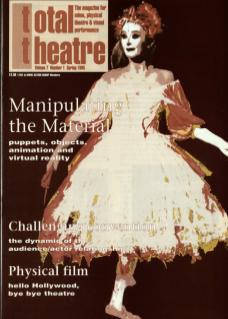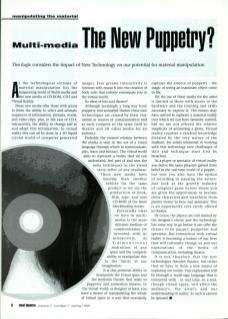At the technological extreme of material manipulation lies the burgeoning world of multimedia and the new media of CD-ROM, CD-I and Virtual Reality.
These new media offer those with access to them the ability to select and animate sequences of information, pictures, words, and video clips, plus, in the case of CD-I, interactivity, the ability to change add to and adapt this information. In virtual reality this can all be done in a 3D liquid crystal world of computer generated images. Ever greater interactivity is foreseen with research into the creation of body suits that entirely encompass you in the virtual world. So what of this and theatre?
Although seemingly a long way from puppetry and animated theatre these new technologies are related by their very nature as sources of communication and as such compete in the same field as theatre and all other media for an audience.
Probably the clearest relation between the media is seen in the use of a visual language through which to communicate, play, learn and interact. The virtual world aims to represent a reality that we can understand, feel part of, and uses the same techniques as the visual storyteller of any medium. These new media have become then another vehicle for the same product as we see the production of book, film, tape, and now CD-ROM of the latest blockbusting stories.
Potentially what we have in multimedia is the most dynamic medium of communication yet invented, with its interactivity, its three-dimensional realisation of any space and the complete ability to manipulate this to the limits of our imagination.
It is this potential ability to manipulate the virtual space and the materials therein that relate to puppetry and animation theatre. In the virtual world, as designer at least, you have a means of manipulating the whole of virtual space in a way that essentially captures the essence of puppetry – the magic of seeing an inanimate object come to life.
Yet the use of these media for the artist is limited to those with access to the hardware and the training and skills necessary to explore it. The means may have arrived to replicate a material reality over which we can have fantastic control, but we are not offered the relative simplicity of animating a glove. Virtual reality requires a rarefied knowledge dictated by the very nature of the medium. For artists interested in working with this technology new challenges of skill and technique must first be broached.
As a player or spectator of virtual reality you derive the same pleasure gained from belief in the real-time world of a puppet – but now you also have the option of recording or pausing the action. Just look at the growth industry of computer game heroes where you are given the opportunity to become these characters and transform from passive viewer to hero and animator. This is an opportunity very rarely offered in theatre.
Of course the players are still limited by the designer's choice and the technology has some way to go before it can offer the chance to be puppet, puppeteer and spectator. But interaction with virtual reality is becoming a feature of our lives that will culturally change us and our expectations of the media of communication, including theatre.
It is not, therefore, that the new technologies threaten theatre, but rather that we have in them a new means of exploring our reality. This exploration will be through a multi-sign language that is interacted with, in real time, in a real, though virtual space, and it will affect the audience's, the artist's and our understanding of reality. As such it cannot be ignored.

